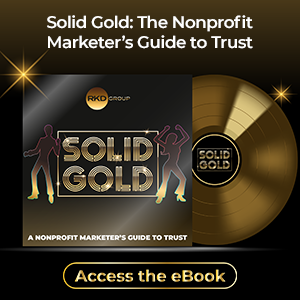The U.S. government shut down on Oct. 1, 2025. That means federal offices have gone dark, paychecks have paused, and uncertainty is rippling through many communities.
For some nonprofit organizations, the impact is immediate and financial. For others, it’s operational, with more families will be showing up for food, housing or help. And for many, it’s simply indirect—donors feel uncertain; attention is splintered; partners are under strain.
The challenge is clear: How do you keep your mission moving when national focus is on the uncertainty in Washington, D.C.? With observations from the last extended government shutdown in 2018, we have some fundraising advice on how to communicate clearly, ask boldly and remind donors why your work is essential.
Step 1: Identify your ‘impact zone’
Every nonprofit is experiencing the shutdown differently. Understanding your level of exposure helps you decide whether to pivot, accelerate or stay the course in fundraising.
- Directly affected by delayed or lost federal funding: Focus on speed and clarity. You may need to accelerate appeals or launch an emergency campaign to offset temporary gaps. Be transparent about your stability and your plan. Donors respond when you show both need and control.
- Experiencing increased demand for services: Prepare for sustained urgency. Your organization will likely see a surge of empathy from your community—harness it quickly. Refresh your messaging. Highlight rising needs. Activate mid-level donors and engage recurring donors to make an additional donation.
- Not directly impacted: Continue fundraising steadily with a focus on your goals and priorities. Avoid silence, but don’t jump into conversations that don’t focus on your mission.
Knowing which group you’re in keeps your fundraising focused and appropriate vs. reactive or tone-deaf.
Step 2: Lead with calm and confidence
When headlines shout “shutdown,” donors instinctively worry about instability. Your first task is to project calm leadership.
- Acknowledge the situation plainly. Avoid jargon or panic. A line as simple as, “Like many organizations, we’re identifying the areas where the shutdown impacts our community” shows transparency and professionalism.
- Reaffirm your control. Donors need to know you’re managing through uncertainty. Phrases like, “Our programs continue uninterrupted, thanks to community support” build confidence.
- Connect the dots. Make the shutdown relevant to your mission, not your organization’s internal challenges. Donors give to impact, not infrastructure.
Tone matters. People respond to honesty paired with hope.
Step 3: Appropriately frame your fundraising message
Your fundraising appeals should evolve quickly when public attention shifts. Here’s how to adapt your message in real time:
- Focus on who is impacted. Lead with the lives affected, not the policy gridlock. Use real stories that capture what’s happening on the ground—the family now relying on a food bank, the furloughed worker who can’t pay her bills, the child whose after-school meal still happens because of donor support.
- Show urgency without alarm. Avoid panic-driven messaging. Instead of, “We’re in crisis,” say, “The need in our community is growing, and your gift right now makes sure no one is left behind.” Urgency grounded in compassion outperforms fear appeals.
- Be specific about delivery. Quantify the donor’s role. “Every $50 keeps our doors open for one more family this week,” or, “Your monthly gift of $25 feeds a neighbor even when federal aid is delayed.” When donors can see the direct result of their action, they’re more likely to give—and keep giving.
- Highlight community over politics. Position your organization as a stabilizing force amid political division. Messages that focus on community resilience, unity and shared responsibility rise above the noise: “While Washington debates, our community is meeting needs.”
Step 4: Engage your donors strategically
The shutdown changes donor psychology, not their generosity. Here’s how to reach them effectively:
- Personalize communications. Segment by donor relationship and history. Major and mid-level donors should hear directly from leadership about the opportunities the organization has to step in.
- Use digital channels to stay visible. Social posts, email updates and quick video messages from leadership can keep supporters connected even when media attention drifts elsewhere.
- Double down on monthly giving. Recurring donations offer your best stability during uncertainty. Frame it as “the most reliable way to keep services uninterrupted—no matter what happens in D.C.”
- Ask for leadership gifts early. Trusted donors often want to help close temporary gaps. Be direct: “Your leadership gift today keeps our programs strong through the shutdown period.”
- Reinforce gratitude constantly. Donors want to feel part of the solution, not just a transaction. Share quick updates: “Because of you, we’re still here for families affected by the shutdown.”
Step 5: Keep the momentum when the shutdown ends
When the government reopens, donor attention will shift fast. Don’t let your story disappear with the headlines.
- Follow up with results. “Here’s what your gift made possible during the shutdown.”
- Share lessons learned. “This experience reminded us why community generosity is essential.”
- Invite donors into resilience. Use the moment to build long-term loyalty: “Your ongoing support helps ensure we’re ready for whatever comes next.”
Crises fade, but trust lasts. Keep nurturing that trust long after the urgency has passed.
Final word: Don’t wait for normal—lead through now
During this challenging time, nonprofits who are affected by the shutdown must respond with steadiness, compassion and a clear voice that calls donors to action.
The best fundraisers remind people that generosity isn’t suspended with the government; it’s amplified when politicians falter.
Your mission doesn’t pause. And neither should your message.

.png?width=750&height=422&name=2025%20Mid-Year%20Benchmarks%20(4).png)




Leave a comment: